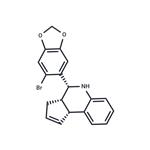Description
G protein-
coupled estrogen receptor (GPER), or GPR30, specifically binds natural and man-
made estrogens. It is thought to be involved in estrogen-
sensitive cancers. GPER knockout mice are fertile, although they exhibit thymic atrophy, impaired glucose tolerance, and altered bone growth. G-
15 is a cell-
permeable non-
steroidal antagonist of GPER (K
i = 20 nM). It displays low affinity cross-
reactivity with the classical estrogen receptor (ER), ERα, so that at doses greater than 1 μM it is capable of mediating limited ER-
dependent transcriptional activity. G-
15 antagonizes the anti-
depressive effects of estrogen
in vivo.
Uses
(3aS,4R,9bR)-4-(6-Bromo-1,3-benzodioxol-5-yl)-3a,4,5,9b-tetrahydro-3H-cyclopenta[c]quinoline is also known as “G-15”, a G-protein-coupled estrogen receptor antagonist designed for the treatment of estrogen-sensitive cancers.
References
[1] dennis mk, burai r, ramesh c, et al. in vivo effects of a gpr30 antagonist. nat chem biol, 2009, 5 (6): 421-427.
[2] g-protein-coupled estrogen receptor and the gper-antagonist g-15 inhibits proliferation in endometriotic cells. fertil steril, 2013, 100 (3): 770-776.
[3] hammond r, nelson d, kline e, et al. chronic treatment with a gpr30 antagonist impairs acquisition of a spatial learning task in young female rats. horm behav, 2012, 62 (4): 367-374.
![(3aS*,4R*,9bR*)-4-(6-Bromo-1,3-benzodioxol-5-yl)-3a,4,5,9b-3H-cyclopenta[c]quinoline Structure](https://www.chemicalbook.com/CAS/20181012/GIF/1161002-05-6.gif)

